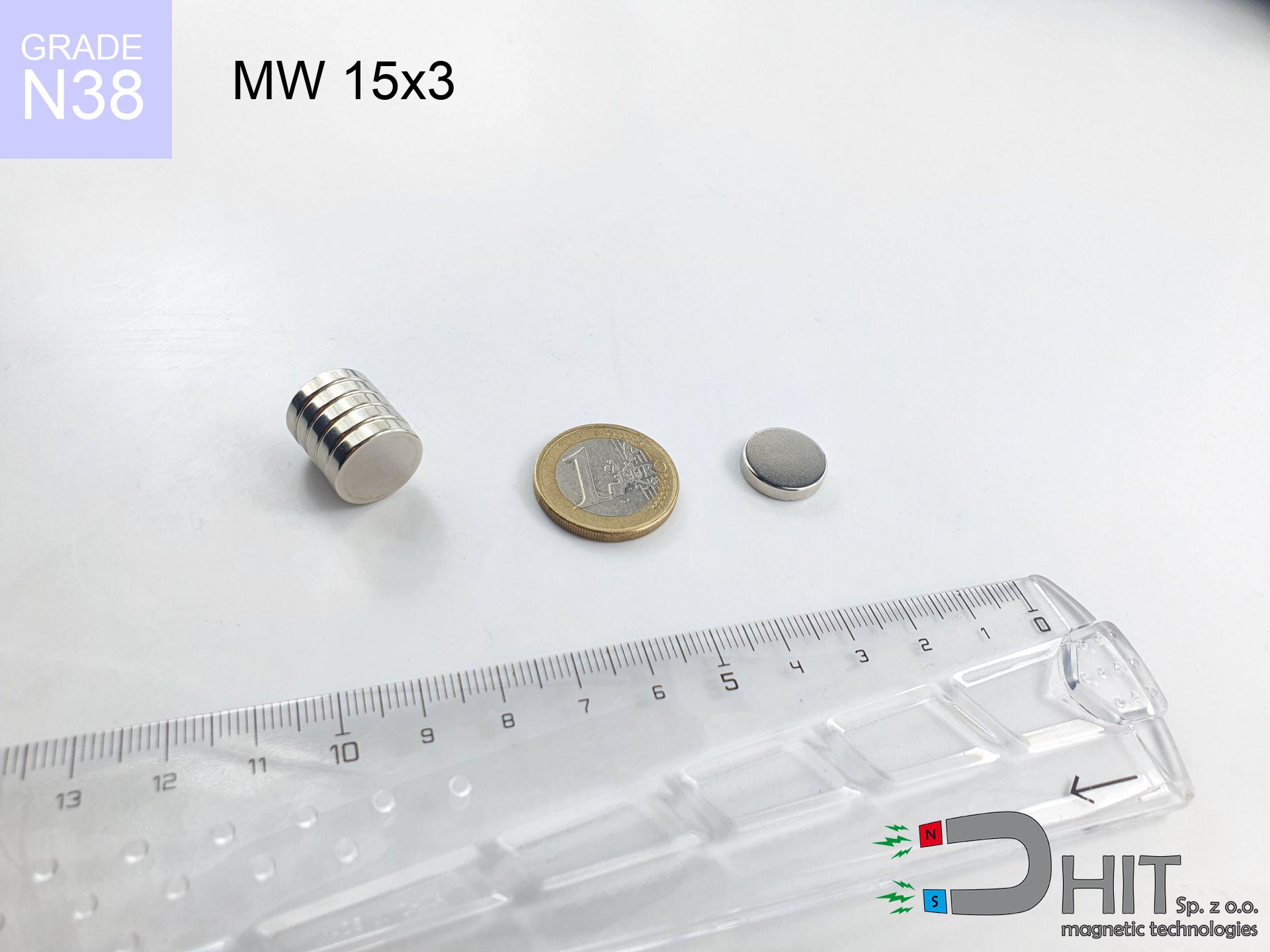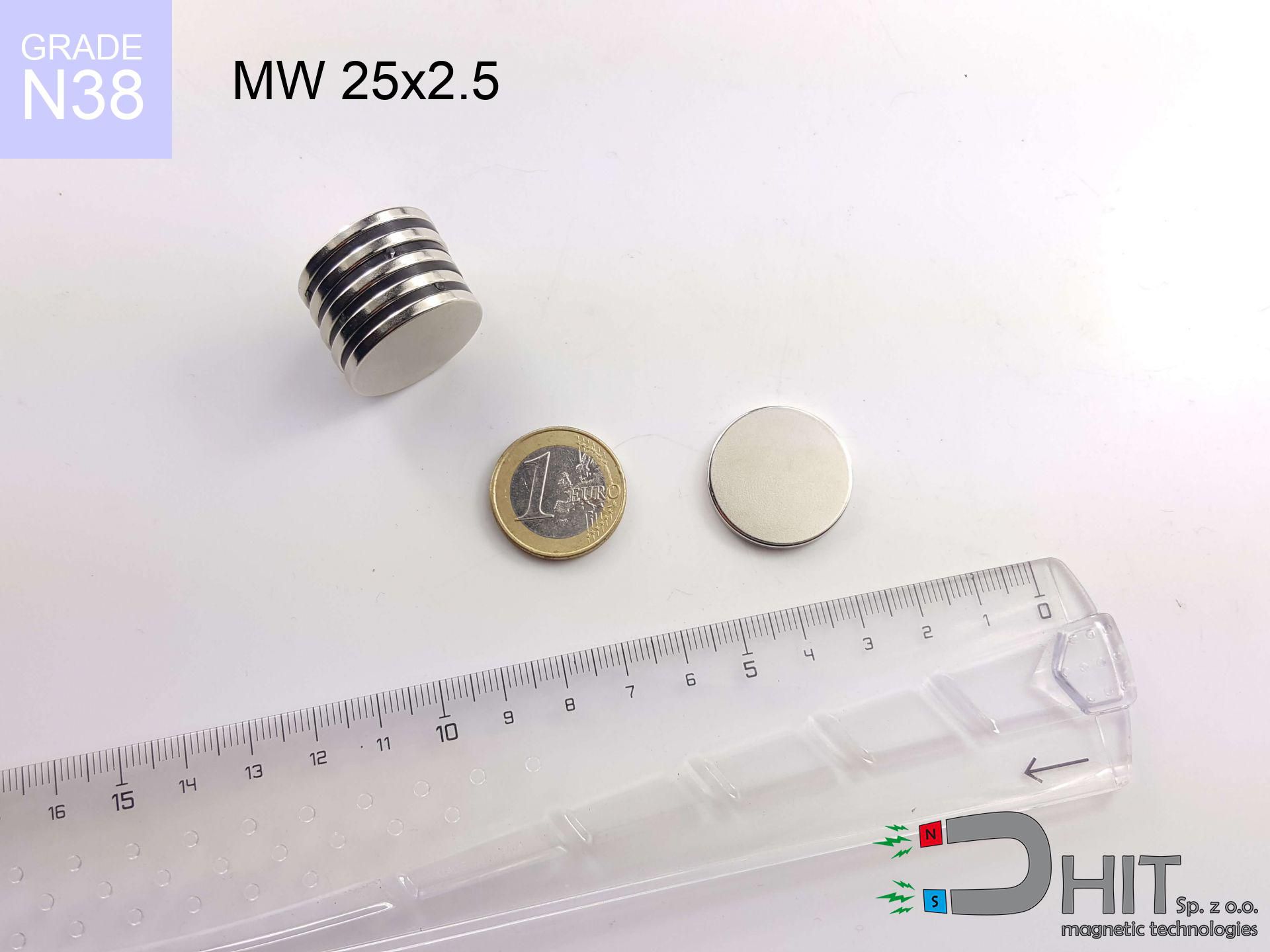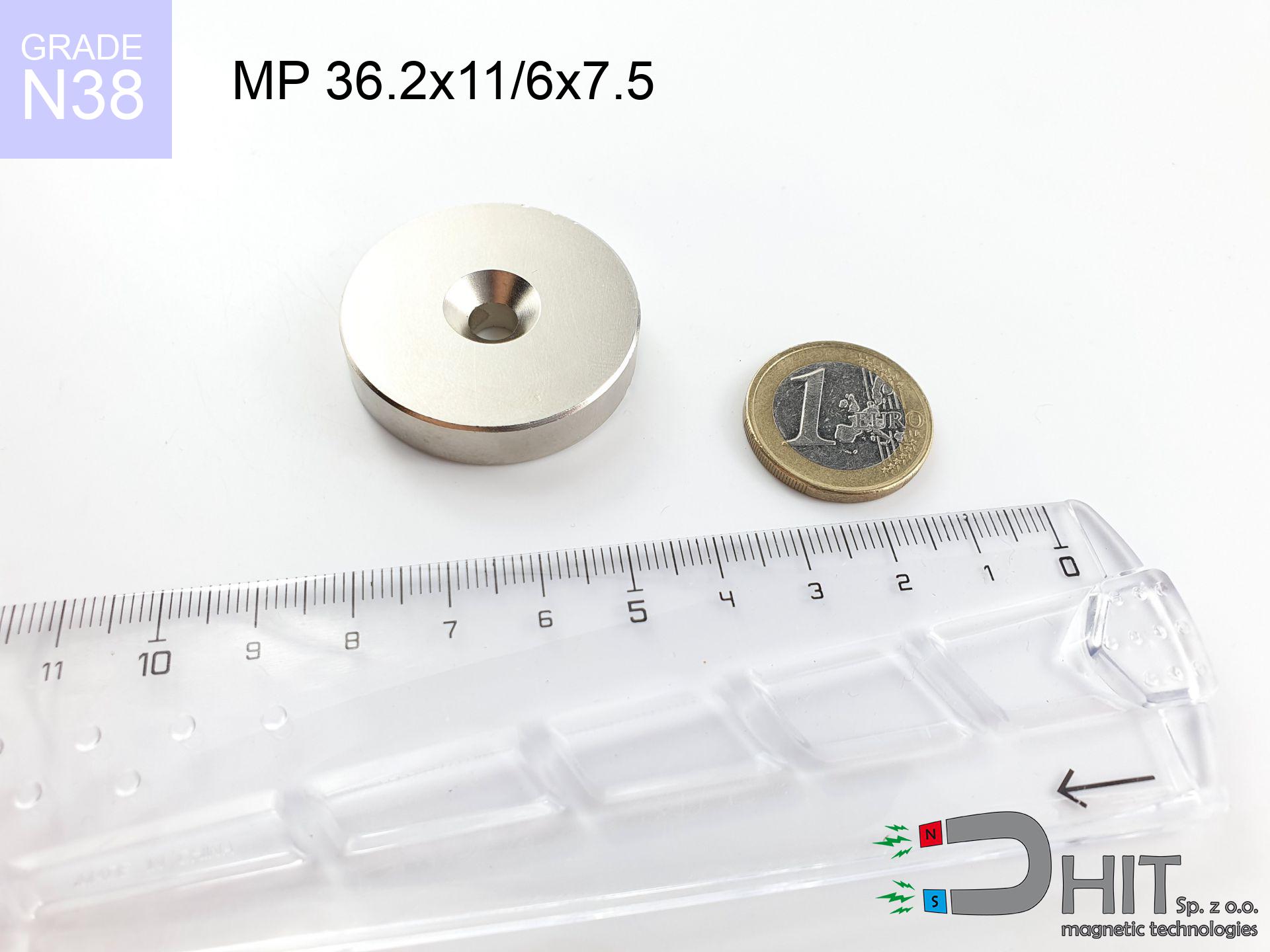MW 16x9 / N38 - cylindrical magnet
cylindrical magnet
Catalog no 010035
GTIN/EAN: 5906301810346
Diameter Ø
16 mm [±0,1 mm]
Height
9 mm [±0,1 mm]
Weight
13.57 g
Magnetization Direction
↑ axial
Load capacity
8.53 kg / 83.64 N
Magnetic Induction
463.05 mT / 4631 Gs
Coating
[NiCuNi] Nickel
7.36 ZŁ with VAT / pcs + price for transport
5.98 ZŁ net + 23% VAT / pcs
bulk discounts:
Need more?
Call us now
+48 888 99 98 98
if you prefer get in touch through
request form
through our site.
Parameters along with form of a neodymium magnet can be reviewed using our
our magnetic calculator.
Orders placed before 14:00 will be shipped the same business day.
Technical of the product - MW 16x9 / N38 - cylindrical magnet
Specification / characteristics - MW 16x9 / N38 - cylindrical magnet
| properties | values |
|---|---|
| Cat. no. | 010035 |
| GTIN/EAN | 5906301810346 |
| Production/Distribution | Dhit sp. z o.o. |
| Country of origin | Poland / China / Germany |
| Customs code | 85059029 |
| Diameter Ø | 16 mm [±0,1 mm] |
| Height | 9 mm [±0,1 mm] |
| Weight | 13.57 g |
| Magnetization Direction | ↑ axial |
| Load capacity ~ ? | 8.53 kg / 83.64 N |
| Magnetic Induction ~ ? | 463.05 mT / 4631 Gs |
| Coating | [NiCuNi] Nickel |
| Manufacturing Tolerance | ±0.1 mm |
Magnetic properties of material N38
| properties | values | units |
|---|---|---|
| remenance Br [min. - max.] ? | 12.2-12.6 | kGs |
| remenance Br [min. - max.] ? | 1220-1260 | mT |
| coercivity bHc ? | 10.8-11.5 | kOe |
| coercivity bHc ? | 860-915 | kA/m |
| actual internal force iHc | ≥ 12 | kOe |
| actual internal force iHc | ≥ 955 | kA/m |
| energy density [min. - max.] ? | 36-38 | BH max MGOe |
| energy density [min. - max.] ? | 287-303 | BH max KJ/m |
| max. temperature ? | ≤ 80 | °C |
Physical properties of sintered neodymium magnets Nd2Fe14B at 20°C
| properties | values | units |
|---|---|---|
| Vickers hardness | ≥550 | Hv |
| Density | ≥7.4 | g/cm3 |
| Curie Temperature TC | 312 - 380 | °C |
| Curie Temperature TF | 593 - 716 | °F |
| Specific resistance | 150 | μΩ⋅cm |
| Bending strength | 250 | MPa |
| Compressive strength | 1000~1100 | MPa |
| Thermal expansion parallel (∥) to orientation (M) | (3-4) x 10-6 | °C-1 |
| Thermal expansion perpendicular (⊥) to orientation (M) | -(1-3) x 10-6 | °C-1 |
| Young's modulus | 1.7 x 104 | kg/mm² |
Physical analysis of the magnet - report
The following data are the outcome of a engineering simulation. Values rely on models for the class Nd2Fe14B. Operational parameters might slightly differ from theoretical values. Treat these data as a reference point for designers.
Table 1: Static pull force (force vs distance) - characteristics
MW 16x9 / N38
| Distance (mm) | Induction (Gauss) / mT | Pull Force (kg) | Risk Status |
|---|---|---|---|
| 0 mm |
4628 Gs
462.8 mT
|
8.53 kg / 8530.0 g
83.7 N
|
medium risk |
| 1 mm |
4072 Gs
407.2 mT
|
6.60 kg / 6603.5 g
64.8 N
|
medium risk |
| 2 mm |
3510 Gs
351.0 mT
|
4.91 kg / 4906.8 g
48.1 N
|
medium risk |
| 3 mm |
2982 Gs
298.2 mT
|
3.54 kg / 3540.1 g
34.7 N
|
medium risk |
| 5 mm |
2097 Gs
209.7 mT
|
1.75 kg / 1751.1 g
17.2 N
|
safe |
| 10 mm |
873 Gs
87.3 mT
|
0.30 kg / 303.3 g
3.0 N
|
safe |
| 15 mm |
411 Gs
41.1 mT
|
0.07 kg / 67.3 g
0.7 N
|
safe |
| 20 mm |
220 Gs
22.0 mT
|
0.02 kg / 19.3 g
0.2 N
|
safe |
| 30 mm |
83 Gs
8.3 mT
|
0.00 kg / 2.7 g
0.0 N
|
safe |
| 50 mm |
22 Gs
2.2 mT
|
0.00 kg / 0.2 g
0.0 N
|
safe |
Table 2: Vertical load (vertical surface)
MW 16x9 / N38
| Distance (mm) | Friction coefficient | Pull Force (kg) |
|---|---|---|
| 0 mm | Stal (~0.2) |
1.71 kg / 1706.0 g
16.7 N
|
| 1 mm | Stal (~0.2) |
1.32 kg / 1320.0 g
12.9 N
|
| 2 mm | Stal (~0.2) |
0.98 kg / 982.0 g
9.6 N
|
| 3 mm | Stal (~0.2) |
0.71 kg / 708.0 g
6.9 N
|
| 5 mm | Stal (~0.2) |
0.35 kg / 350.0 g
3.4 N
|
| 10 mm | Stal (~0.2) |
0.06 kg / 60.0 g
0.6 N
|
| 15 mm | Stal (~0.2) |
0.01 kg / 14.0 g
0.1 N
|
| 20 mm | Stal (~0.2) |
0.00 kg / 4.0 g
0.0 N
|
| 30 mm | Stal (~0.2) |
0.00 kg / 0.0 g
0.0 N
|
| 50 mm | Stal (~0.2) |
0.00 kg / 0.0 g
0.0 N
|
Table 3: Vertical assembly (shearing) - behavior on slippery surfaces
MW 16x9 / N38
| Surface type | Friction coefficient / % Mocy | Max load (kg) |
|---|---|---|
| Raw steel |
µ = 0.3
30% Nominalnej Siły
|
2.56 kg / 2559.0 g
25.1 N
|
| Painted steel (standard) |
µ = 0.2
20% Nominalnej Siły
|
1.71 kg / 1706.0 g
16.7 N
|
| Oily/slippery steel |
µ = 0.1
10% Nominalnej Siły
|
0.85 kg / 853.0 g
8.4 N
|
| Magnet with anti-slip rubber |
µ = 0.5
50% Nominalnej Siły
|
4.27 kg / 4265.0 g
41.8 N
|
Table 4: Material efficiency (substrate influence) - power losses
MW 16x9 / N38
| Steel thickness (mm) | % power | Real pull force (kg) |
|---|---|---|
| 0.5 mm |
|
0.85 kg / 853.0 g
8.4 N
|
| 1 mm |
|
2.13 kg / 2132.5 g
20.9 N
|
| 2 mm |
|
4.27 kg / 4265.0 g
41.8 N
|
| 5 mm |
|
8.53 kg / 8530.0 g
83.7 N
|
| 10 mm |
|
8.53 kg / 8530.0 g
83.7 N
|
Table 5: Thermal stability (stability) - power drop
MW 16x9 / N38
| Ambient temp. (°C) | Power loss | Remaining pull | Status |
|---|---|---|---|
| 20 °C | 0.0% |
8.53 kg / 8530.0 g
83.7 N
|
OK |
| 40 °C | -2.2% |
8.34 kg / 8342.3 g
81.8 N
|
OK |
| 60 °C | -4.4% |
8.15 kg / 8154.7 g
80.0 N
|
OK |
| 80 °C | -6.6% |
7.97 kg / 7967.0 g
78.2 N
|
|
| 100 °C | -28.8% |
6.07 kg / 6073.4 g
59.6 N
|
Table 6: Two magnets (attraction) - field collision
MW 16x9 / N38
| Gap (mm) | Attraction (kg) (N-S) | Repulsion (kg) (N-N) |
|---|---|---|
| 0 mm |
26.55 kg / 26554 g
260.5 N
5 658 Gs
|
N/A |
| 1 mm |
23.52 kg / 23517 g
230.7 N
8 711 Gs
|
21.17 kg / 21165 g
207.6 N
~0 Gs
|
| 2 mm |
20.56 kg / 20557 g
201.7 N
8 145 Gs
|
18.50 kg / 18501 g
181.5 N
~0 Gs
|
| 3 mm |
17.80 kg / 17796 g
174.6 N
7 578 Gs
|
16.02 kg / 16017 g
157.1 N
~0 Gs
|
| 5 mm |
13.01 kg / 13015 g
127.7 N
6 481 Gs
|
11.71 kg / 11713 g
114.9 N
~0 Gs
|
| 10 mm |
5.45 kg / 5451 g
53.5 N
4 194 Gs
|
4.91 kg / 4906 g
48.1 N
~0 Gs
|
| 20 mm |
0.94 kg / 944 g
9.3 N
1 746 Gs
|
0.85 kg / 850 g
8.3 N
~0 Gs
|
| 50 mm |
0.02 kg / 21 g
0.2 N
260 Gs
|
0.02 kg / 19 g
0.2 N
~0 Gs
|
Table 7: Safety (HSE) (implants) - warnings
MW 16x9 / N38
| Object / Device | Limit (Gauss) / mT | Safe distance |
|---|---|---|
| Pacemaker | 5 Gs (0.5 mT) | 8.5 cm |
| Hearing aid | 10 Gs (1.0 mT) | 7.0 cm |
| Timepiece | 20 Gs (2.0 mT) | 5.5 cm |
| Mobile device | 40 Gs (4.0 mT) | 4.0 cm |
| Car key | 50 Gs (5.0 mT) | 4.0 cm |
| Payment card | 400 Gs (40.0 mT) | 2.0 cm |
| HDD hard drive | 600 Gs (60.0 mT) | 1.5 cm |
Table 8: Collisions (cracking risk) - warning
MW 16x9 / N38
| Start from (mm) | Speed (km/h) | Energy (J) | Predicted outcome |
|---|---|---|---|
| 10 mm |
25.84 km/h
(7.18 m/s)
|
0.35 J | |
| 30 mm |
43.80 km/h
(12.17 m/s)
|
1.00 J | |
| 50 mm |
56.54 km/h
(15.71 m/s)
|
1.67 J | |
| 100 mm |
79.96 km/h
(22.21 m/s)
|
3.35 J |
Table 9: Coating parameters (durability)
MW 16x9 / N38
| Technical parameter | Value / Description |
|---|---|
| Coating type | [NiCuNi] Nickel |
| Layer structure | Nickel - Copper - Nickel |
| Layer thickness | 10-20 µm |
| Salt spray test (SST) ? | 24 h |
| Recommended environment | Indoors only (dry) |
Table 10: Electrical data (Flux)
MW 16x9 / N38
| Parameter | Value | SI Unit / Description |
|---|---|---|
| Magnetic Flux | 9 394 Mx | 93.9 µWb |
| Pc Coefficient | 0.63 | High (Stable) |
Table 11: Submerged application
MW 16x9 / N38
| Environment | Effective steel pull | Effect |
|---|---|---|
| Air (land) | 8.53 kg | Standard |
| Water (riverbed) |
9.77 kg
(+1.24 kg Buoyancy gain)
|
+14.5% |
1. Shear force
*Caution: On a vertical surface, the magnet retains only approx. 20-30% of its nominal pull.
2. Efficiency vs thickness
*Thin steel (e.g. computer case) drastically reduces the holding force.
3. Heat tolerance
*For N38 grade, the critical limit is 80°C.
4. Demagnetization curve and operating point (B-H)
chart generated for the permeance coefficient Pc (Permeance Coefficient) = 0.63
The chart above illustrates the magnetic characteristics of the material within the second quadrant of the hysteresis loop. The solid red line represents the demagnetization curve (material potential), while the dashed blue line is the load line based on the magnet's geometry. The Pc (Permeance Coefficient), also known as the load line slope, is a dimensionless value that describes the relationship between the magnet's shape and its magnetic stability. The intersection of these two lines (the black dot) is the operating point — it determines the actual magnetic flux density generated by the magnet in this specific configuration. A higher Pc value means the magnet is more 'slender' (tall relative to its area), resulting in a higher operating point and better resistance to irreversible demagnetization caused by external fields or temperature. A value of 0.42 is relatively low (typical for flat magnets), meaning the operating point is closer to the 'knee' of the curve — caution is advised when operating at temperatures near the maximum limit to avoid strength loss.
Material specification
| iron (Fe) | 64% – 68% |
| neodymium (Nd) | 29% – 32% |
| boron (B) | 1.1% – 1.2% |
| dysprosium (Dy) | 0.5% – 2.0% |
| coating (Ni-Cu-Ni) | < 0.05% |
Environmental data
| recyclability (EoL) | 100% |
| recycled raw materials | ~10% (pre-cons) |
| carbon footprint | low / zredukowany |
| waste code (EWC) | 16 02 16 |
Other products
Pros and cons of rare earth magnets.
Pros
- They virtually do not lose power, because even after 10 years the performance loss is only ~1% (based on calculations),
- Magnets perfectly defend themselves against demagnetization caused by ambient magnetic noise,
- In other words, due to the aesthetic finish of silver, the element gains a professional look,
- They feature high magnetic induction at the operating surface, which improves attraction properties,
- Due to their durability and thermal resistance, neodymium magnets can operate (depending on the shape) even at high temperatures reaching 230°C or more...
- Thanks to flexibility in designing and the ability to customize to individual projects,
- Universal use in modern industrial fields – they are used in mass storage devices, electric drive systems, advanced medical instruments, as well as technologically advanced constructions.
- Thanks to their power density, small magnets offer high operating force, in miniature format,
Limitations
- To avoid cracks upon strong impacts, we suggest using special steel holders. Such a solution secures the magnet and simultaneously improves its durability.
- When exposed to high temperature, neodymium magnets suffer a drop in power. Often, when the temperature exceeds 80°C, their strength decreases (depending on the size and shape of the magnet). For those who need magnets for extreme conditions, we offer [AH] versions withstanding up to 230°C
- Due to the susceptibility of magnets to corrosion in a humid environment, we suggest using waterproof magnets made of rubber, plastic or other material resistant to moisture, when using outdoors
- Limited ability of producing nuts in the magnet and complicated shapes - preferred is casing - mounting mechanism.
- Possible danger to health – tiny shards of magnets are risky, in case of ingestion, which becomes key in the aspect of protecting the youngest. It is also worth noting that small components of these devices can disrupt the diagnostic process medical after entering the body.
- With large orders the cost of neodymium magnets is economically unviable,
Pull force analysis
Magnetic strength at its maximum – what affects it?
- with the contact of a yoke made of low-carbon steel, guaranteeing maximum field concentration
- with a cross-section minimum 10 mm
- with an ground contact surface
- without the slightest clearance between the magnet and steel
- under axial application of breakaway force (90-degree angle)
- in stable room temperature
Determinants of practical lifting force of a magnet
- Space between magnet and steel – even a fraction of a millimeter of distance (caused e.g. by veneer or unevenness) significantly weakens the magnet efficiency, often by half at just 0.5 mm.
- Direction of force – highest force is reached only during perpendicular pulling. The shear force of the magnet along the surface is typically several times lower (approx. 1/5 of the lifting capacity).
- Wall thickness – the thinner the sheet, the weaker the hold. Part of the magnetic field penetrates through instead of converting into lifting capacity.
- Steel type – low-carbon steel attracts best. Alloy admixtures decrease magnetic properties and holding force.
- Surface condition – smooth surfaces guarantee perfect abutment, which increases force. Rough surfaces weaken the grip.
- Temperature – heating the magnet causes a temporary drop of induction. It is worth remembering the thermal limit for a given model.
Holding force was tested on a smooth steel plate of 20 mm thickness, when a perpendicular force was applied, whereas under shearing force the lifting capacity is smaller. Moreover, even a slight gap between the magnet’s surface and the plate lowers the load capacity.
Warnings
No play value
Strictly keep magnets out of reach of children. Ingestion danger is significant, and the consequences of magnets clamping inside the body are life-threatening.
Permanent damage
Regular neodymium magnets (grade N) undergo demagnetization when the temperature exceeds 80°C. Damage is permanent.
Protect data
Intense magnetic fields can erase data on credit cards, HDDs, and other magnetic media. Maintain a gap of min. 10 cm.
Immense force
Before starting, check safety instructions. Sudden snapping can destroy the magnet or injure your hand. Think ahead.
Magnet fragility
Protect your eyes. Magnets can fracture upon uncontrolled impact, launching shards into the air. Wear goggles.
Pinching danger
Mind your fingers. Two large magnets will snap together immediately with a force of several hundred kilograms, destroying everything in their path. Exercise extreme caution!
Pacemakers
Individuals with a ICD have to maintain an large gap from magnets. The magnetism can interfere with the functioning of the life-saving device.
Flammability
Mechanical processing of NdFeB material carries a risk of fire risk. Magnetic powder oxidizes rapidly with oxygen and is hard to extinguish.
Keep away from electronics
Navigation devices and smartphones are highly sensitive to magnetic fields. Direct contact with a powerful NdFeB magnet can ruin the internal compass in your phone.
Metal Allergy
Certain individuals have a hypersensitivity to nickel, which is the common plating for neodymium magnets. Extended handling may cause an allergic reaction. We suggest wear safety gloves.





![BM 950x180x70 [4x M8] - magnetic beam BM 950x180x70 [4x M8] - magnetic beam](https://cdn3.dhit.pl/graphics/products/bm-950x180x70-4x-m8-ves.jpg)



